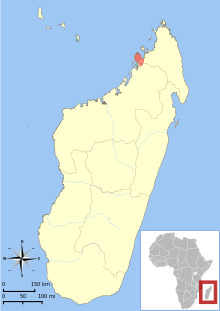Pariente's fork-marked lemur
| Pariente's fork-marked lemur | |
|---|---|
| Scientific classification | |
| Kingdom: | Animalia |
| Phylum: | Chordata |
| Clade: | Synapsida |
| Class: | Mammalia |
| Order: | Primates |
| Suborder: | Strepsirrhini |
| Family: | Cheirogaleidae |
| Genus: | Phaner |
| Species: | P. parienti |
| Binomial name | |
| Phaner parienti Groves and Tattersall, 1991[3] | |
 | |
| Pariente's fork-crowned lemur range[1] | |
Pariente's fork-marked lemur (Phaner parienti), or the Sambirano fork-marked lemur is a species of lemur endemic to the Sambirano region of north-western Madagascar. This lemur has light brown to gray upperparts, a prominent facial fork and dorsal stripe that runs from the tail's tip to the point where it splits on the lemur's head to rejoin at the nose, and a white-tipped tail. It is found in lowland and mid-altitude humid forests and is nocturnal. It is an omnivore, eating tree gum, sap, bud exudes, insects and larvae. It sleeps in nests that have been abandoned by other lemurs, particularly Coquerel's giant mouse lemur. This species is relatively unknown, though it is threatened by habitat destruction. It was previously considered a subspecies of the Masoala fork-marked lemur (Phaner furcifer).[4]
References
- 1 2 Andriaholinirina, N.; et al. (2014). "Phaner parienti". IUCN Red List of Threatened Species. Version 2014.1. International Union for Conservation of Nature. Retrieved 2014-06-15.
- ↑ "Checklist of CITES Species". CITES. UNEP-WCMC. Retrieved 18 March 2015.
- ↑ Groves, C.P. (2005). Wilson, D.E.; Reeder, D.M., eds. Mammal Species of the World: A Taxonomic and Geographic Reference (3rd ed.). Baltimore: Johns Hopkins University Press. p. 114. OCLC 62265494. ISBN 0-801-88221-4.
- ↑ Garbutt, Nick (1999). Mammals of Madagascar. New Haven: Yale Press.
